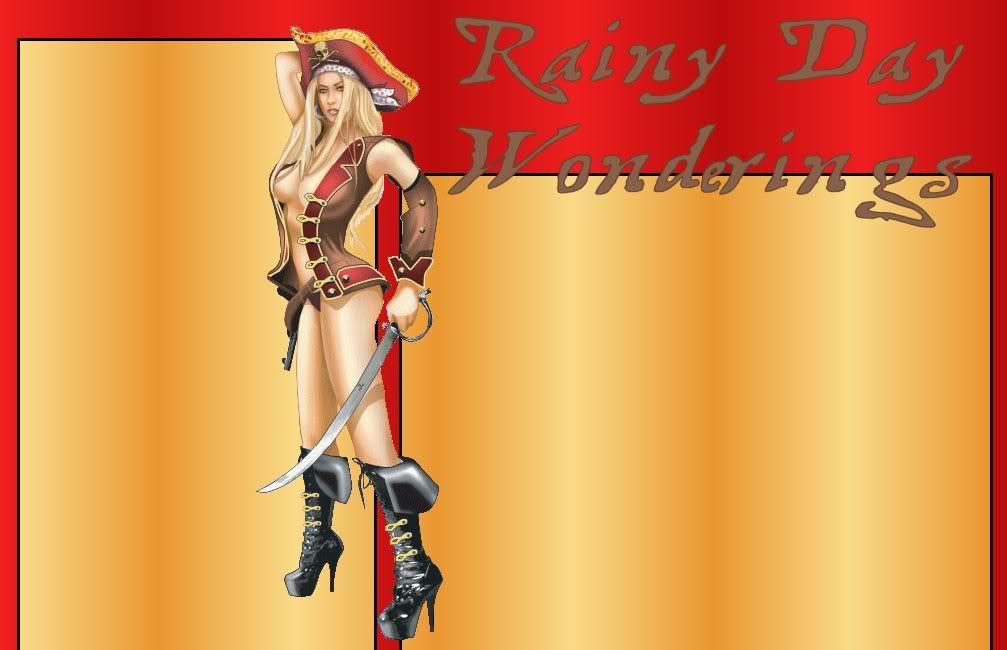

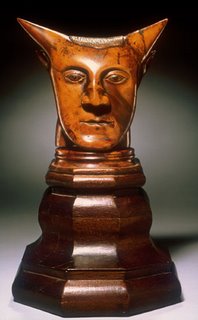
In 1891 Gauguin auctioned his paintings to raise money for a voyage to Tahiti, which he undertook that same year. Two years later illness forced him to return to Paris, where, with the critic Charles Morice, he began Noa Noa, a book about Tahiti. Gauguin was able to return to Tahiti in 1895. He unsuccessfully attempted suicide in January 1898, not long after completing his mural-sized painting Where Do We Come From? What Are We? Where Are We Going? In 1899 he championed the cause of French settlers in Tahiti in a political journal, Les Guêpes, and founded his own periodical, Le Sourire. Gauguin’s other writings include Cahier pour Aline (1892), L’Espirit moderne et le catholicisme (1897 and 1902) and Avant et après (1902), all of which are autobiographical.
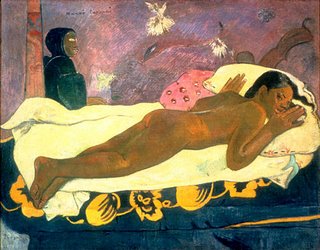 "May the day come soon when I'll be myself in the woods of an ocean island! To live there in ecstasy, calmness and art. . . . There in Tahiti I shall be able to listen to the sweet murmuring music of my heart's beating in the silence of the beautiful tropical nights." --Paul Gauguin
"May the day come soon when I'll be myself in the woods of an ocean island! To live there in ecstasy, calmness and art. . . . There in Tahiti I shall be able to listen to the sweet murmuring music of my heart's beating in the silence of the beautiful tropical nights." --Paul Gauguin
In 1901 the artist moved to the Marquesas, where he died by suicide on May 8, 1903.
Now on to Richard Dadd.... 1817-1886
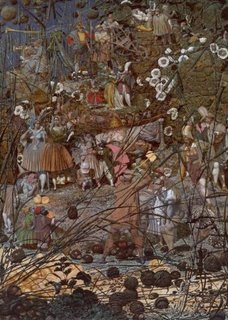
The Fairy Feller's Master-Stroke 1855-64, Oil on canvas
The fourth of eleven children of a chemist and druggist, Richard Dadd began his artistic training at the age of thirteen. He studied miniature painting, portraiture, and landscapes and was accepted to the prestigious Royal Academy for further study after turning twenty. Academy professors remarked on his gentleness, cheerful good nature, and great promise as an artist.
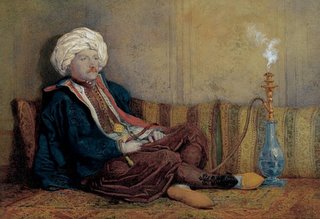
In 1842 Dadd left England on a one-year drawing trip throughout Europe and the Middle East. Shortly after his return, he lost his sanity, as had three of his siblings. Dadd murdered his father, attempted to kill a stranger, and spoke of killing the pope and the emperor of Austria, insisting that the Egyptian god Osiris requested these acts. In 1843 the courts and his family committed him to an insane asylum, where he remained for the next forty-three years, continuing to paint.
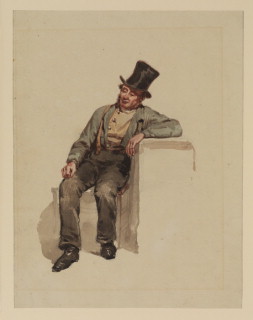
Well, yesterday was a very looong day...Have a great weekend everyone, see you on Monday!~Rain
N Posted by Rain at 6/03/2006 12:28:00 AM

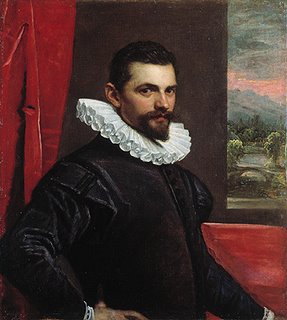
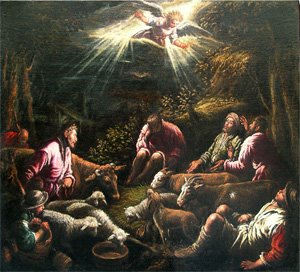
The most celebrated and ambitious American poet of his era, ROBERT LOWELL (1917-1977) transformed the particulars of his prominent New England family’s background and turbulent private life into controversial art. Lowell’s book Life Studies (1959), which reveals his struggles with madness, alcohol, and marital infidelity, gave rise to the so-called “confessional” school. In subsequent works he explored political issues and historical figures while extending his experiments in verse technique.
Dolphin byRobert Lowell
My Dolphin, you only guide me by surprise,
a captive as Racine, the man of craft,
drawn through his maze of iron composition
by the incomparable wandering voice of Phèdre.
When I was troubled in mind, you made for my body
caught in its hangman's-knot of sinking lines,
the glassy bowing and scraping of my will. . . .
I have sat and listened to too many
words of the collaborating muse,
and plotted perhaps too freely with my life,
not avoiding injury to others,
not avoiding injury to myself--
to ask compassion . . . this book, half fiction,
an eelnet made by man for the eel fighting
my eyes have seen what my hand did.
~*******~
Mr. Edwards and the Spider
by Robert Lowell
I saw the spiders marching through the air,
Swimming from tree to tree that mildewed day
In latter August when the hay
Came creaking to the barn. But where
The wind is westerly,
Where gnarled November makes the spiders fly
Into the apparitions of the sky,
They purpose nothing but their ease and die
Urgently beating east to sunrise and the sea;
What are we in the hands of the great God?
It was in vain you set up thorn and briar
In battle array against the fire
And treason crackling in your blood;
For the wild thorns grow tame
And will do nothing to oppose the flame;
Your lacerations tell the losing game
You play against a sickness past your cure.
How will the hands be strong? How will the heart endure?
A very little thing, a little worm,
Or hourglass-blazoned spider, it is said,
Can kill a tiger. Will the dead
Hold up his mirror and affirm
To the four winds the smell
And flash of his authority? It’s well
If God who holds you to the pit of hell,
Much as one holds a spider, will destroy,
Baffle and dissipate your soul. As a small boy
On Windsor Marsh, I saw the spider die
When thrown into the bowels of fierce fire:
There’s no long struggle, no desire
To get up on its feet and fly
It stretches out its feet
And dies. This is the sinner’s last retreat;
Yes, and no strength exerted on the heat
Then sinews the abolished will, when sick
And full of burning, it will whistle on a brick.
But who can plumb the sinking of that soul?
Josiah Hawley, picture yourself cast
Into a brick-kiln where the blast
Fans your quick vitals to a coal—
If measured by a glass,
How long would it seem burning! Let there pass
A minute, ten, ten trillion; but the blaze
Is infinite, eternal: this is death,
To die and know it. This is the Black Widow, death
From Selected Poems by Robert Lowell, published by Farrar, Straus & Giroux, Inc. Copyright © 1976, 1977 by Robert Lowell.
Pulitzer Prize for Poetry1947 for Lord Weary's Castle
Pulitzer Prize for Poetry 1974 for The Dolphin
National Book Award for Poetry1960 for Life Studies
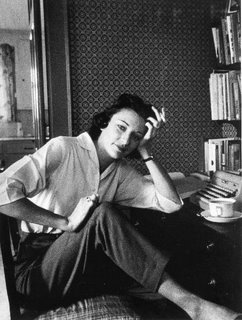 Anne Sexton
Anne SextonAnne Gray Harvey was born in Newton, Massachusetts, in 1928. She attended Garland Junior College for one year and married Alfred Muller Sexton II at age nineteen. In 1953 she gave birth to a daughter. In 1954 she was diagnosed with postpartum depression, suffered her first mental breakdown, and was admitted to Westwood Lodge, a neuropsychiatric hospital she would repeatedly return to for help. In 1955, following the birth of her second daughter, Sexton suffered another breakdown and was hospitalized again; her children were sent to live with her husband's parents. That same year, on her birthday, she attempted suicide.In 1974 at the age of 46, despite a successful writing career--she won the Pulitzer Prize for poetry in 1967 for Live or Die--she lost her battle with mental illness and committed suicide.
The Truth the Dead Know
by Anne Sexton
For my Mother, born March 1902, died March 1959 and my Father, born February 1900, died June 1959
Gone, I say and walk from church,
refusing the stiff procession to the grave,
letting the dead ride alone in the hearse.
It is June. I am tired of being brave.
We drive to the Cape. I cultivate
myself where the sun gutters from the sky,
where the sea swings in like an iron gate
and we touch. In another country people die.
My darling, the wind falls in like stones
from the whitehearted water and when we touch
we enter touch entirely. No one's alone.
Men kill for this, or for as much.
And what of the dead? They lie without shoes
in the stone boats. They are more like stone
than the sea would be if it stopped. They refuse
to be blessed, throat, eye and knucklebone.
From The Complete Poems by Anne Sexton, published by Houghton Mifflin Company.
Wanting to Die
by Anne Sexton
Since you ask, most days I cannot remember.
I walk in my clothing, unmarked by that voyage.
Then the almost unnameable lust returns.
Even then I have nothing against life.
I know well the grass blades you mention,
the furniture you have placed under the sun.
But suicides have a special language.
Like carpenters they want to know which tools.
They never ask why build.
Twice I have so simply declared myself,
have possessed the enemy, eaten the enemy,
have taken on his craft, his magic.
In this way, heavy and thoughtful,
warmer than oil or water,
I have rested, drooling at the mouth-hole.
I did not think of my body at needle point.
Even the cornea and the leftover urine were gone.
Suicides have already betrayed the body.
Still-born, they don’t always die,
but dazzled, they can’t forget a drug so sweet
that even children would look on and smile.
To thrust all that life under your tongue!—
that, all by itself, becomes a passion.
Death’s a sad bone; bruised, you’d say,
and yet she waits for me, year after year,
to so delicately undo an old wound,
to empty my breath from its bad prison.
Balanced there, suicides sometimes meet,
raging at the fruit a pumped-up moon,
leaving the bread they mistook for a kiss,
leaving the page of the book carelessly open,
something unsaid, the phone off the hook
and the love whatever it was, an infection.
Anne Sexton, “Wanting to Die” from The Complete Poems of Anne Sexton (Boston: Houghton Mifflin, 1981).
Thank goodness it's friday...I am really looking forward to my weekend! Hey...I forgot, it's payday, yay!~Rain
N Posted by Rain at 6/02/2006 12:07:00 AM

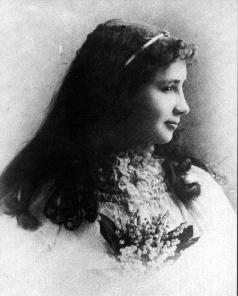 Helen Keller
Helen Keller
On June 1, 1968, Helen Keller dies in Westport, Connecticut, at the age of 87. Blind and deaf from infancy, Keller circumvented her disabilities to become a world-renowned writer and lecturer.
Helen Adams Keller was born on June 27, 1880, on a farm near Tuscumbia, Alabama. A normal infant, she was stricken with an illness at 19 months, probably scarlet fever, which left her blind and deaf. For the next four years, she lived at home, a mute and unruly child. Special education for the blind and deaf was just beginning at the time, and it was not until after Helen's sixth birthday that her parents had her elxamined by an eye physician interested in the blind. He referred the Kellers to Alexander Graham Bell, the inventor of the telephone and a pioneer in teaching speech to the deaf. Bell examined Helen and arranged to have a teacher sent for her from the Perkins Institution for the Blind in Boston.
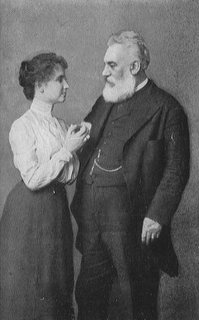
Helen Keller and Dr. Alexander Graham Bell
"I do not want the peace which passeth understanding, I want the understanding which passeth understanding. I want the understanding which bringeth peace." Helen Keller on education
Helen Keller and Anne Sullivan
"My life has been happy because I have had wonderful friends and plenty of interesting work to do," Helen Keller once wrote, adding, "I seldom think about my limitations, and they never make me sad. Perhaps there is just a touch of yearning at times, but it is vague, like a breeze among flowers. The wind passes, and the flowers are content."
Helen Keller and Mark Twain
"No pessimist ever discovered the secret of the stars or sailed an uncharted land, or opened a new doorway for the human spirit." and "Many persons have the wrong idea of what constitutes true happiness. It is not attained through self-gratification but through fidelity to a worthy purpose." Helen Keller
In 1900, Helen Keller was accepted into Radcliffe, a prestigious women's college in Cambridge with classes taught by Harvard University faculty. She was a determined and brilliant student, and while still at Radcliffe her first autobiography, The Story of My Life, was published serially in The Ladies Home Journal and then as a book. In 1904, she graduated cum laude from Radcliffe. Keller became an accomplished writer, publishing, among other books, The World I Live In (1908), Out of the Dark (1913), My Religion (1927), Helen Keller's Journal (1938), and Teacher (1955)
This photograph from 1961 shows Helen visiting President John F. Kennedy in the White House. The two are seated with Helen's secretary Evelyn D. Seide; a few Presidential aides are standing nearby. Everyone is smiling, including Helen, who is explaining something to the President.
"When one door of happiness closes, another opens; but often we look so long at the closed door that we do not see the one which has been opened for us." Helen Keller
With that being said, Today I am grateful for;
What are you grateful for?
N Posted by Rain at 6/01/2006 12:15:00 AM


This map, published by the Southern Pacific Railroad and the State Board of Trade, promoted the idea that California was a place of great natural beauty and with rich agricultural soil. Each county in the state is listed, with its acreage, and with the main agricultural products and extractive industries that happened in the county. Oranges, lumber, figs, almonds, honey, cereals, quicksilver and semi tropical fruits were some of the things listed. The images that decorate the map, and the text that was included which claimed California had the grandest scenery in North America's and that the air was as dry, pure, and invigorating and promoted tourism to the state.
Fruit crate labels began to be designed at the end of the 19th century . As refrigerated railroad cars helped make the long distance shipping of perishable produce such as fruits and vegetables possible, the industry developed labels so shippers and merchants could more easily identify what was in the crates. These vibrant and colorful paper labels were pasted onto the boxes they shipped around the country and were a lively mobile advertisement. Labels featured a wide range of designs. Although the produce in question be it orange, lemon, apple, strawberry or some other fruit's was usually depicted on the label, it wasn't always the case. Labels drew on a wide range of iconographic images--from idyllic pastoral scenes, women, animals, and patriotic imagery--in order to entice people to buy fruit.

This Blue Flag brand label's patriotic color scheme, and the reference to the Standard Apple Act of 1917, suggests that it was probably made during or immediately after World War I.
Fancy Quality Pajaro Valley Apples. Shipped by Gilmore & Copeland.Blue Flag Brand. Watsonville California. Guarenteed by the packer to comply with Standard Apple Act, 1917
Utility Brand fruit crate label
This 1920s fruit crate label put an idealized version of the apple in an idyllic and ordered pastoral scene. Apples were big business in the Pajaro Valley in the 1920s: there were 37 fruit packing houses in Watsonville in 1925. In that same year, Polk's Watsonville City Directory declared that the valley wasthe largest apple and berry producing center in California, and the third largest shipping point between San Francisco and Los Angeles.

A woman, idealized idealised fruit, and a pastoral backdrop: this 1890s label evokes patriotic imagery and shows an idyllic rural America that (if it ever really existed) was disappearing under the weight of industrialization. As Watsonville's surrounds became dotted with apple orchards, packing and shipping the fruit from the trees became a big part of the region's economy. In 1908, there were over thirty packing houses in the area.
Watsonville, California
You may be wondering why a post about fruit labels? My mother, her younger brother D and my Grandfather live in a tent on one of the many farms in the area. They picked apples for basic survial. My mother had good memories of the people in the town, her family always had enough to eat even if it meant apples and strawberries everyday. She said the air was always sweet in Watsonville.
N Posted by Rain at 5/31/2006 12:14:00 AM


Ralph Blakelock spent the years 1869 - 72 in the West where he painted a number of topographical scenes. On his return East, he evolved the aesthetic that was to dominate his art - quiet evening scenes, large oak trees silhouetted against a sunset or moonlight glow, often with Indian camps sparkling in the dark beneath. Apparently predisposed to melancholia, the artist suffered a mental collapse in 1891 and was institutionalized briefly. Throughout the 1890s his emotional state gradually deteriorated, manifesting in delusions of grandeur and eccentric dress. A violent episode in 1899 resulted in the artist's uninterrupted confinement until 1916, after which he was hospitalized periodically until his death. Ironically the recognition that he had long sought came to him only after he was institutionalized.
 Despite personal charm, wealth, and an unrivaled reputation for high-style caricatures of his celebrity friends, Barton could not escape his chronic manic depression and took his own life shortly before his fortieth birthday in 1931. But he had helped to invent a new type of celebrity caricature that was too stylish to be cruel. "It is not the caricaturist's job to be penetrating," he noted. "It is his job to put down the figure a man cuts before his fellows in his attempt to conceal the writhings of his soul."
Despite personal charm, wealth, and an unrivaled reputation for high-style caricatures of his celebrity friends, Barton could not escape his chronic manic depression and took his own life shortly before his fortieth birthday in 1931. But he had helped to invent a new type of celebrity caricature that was too stylish to be cruel. "It is not the caricaturist's job to be penetrating," he noted. "It is his job to put down the figure a man cuts before his fellows in his attempt to conceal the writhings of his soul."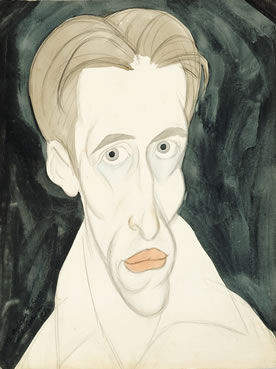 Self-portrait Ralph Barton
Self-portrait Ralph Barton
Watercolor and graphite on paperboard mounted on illustration board, circa 1925
"The human soul would be a hideous object if it were possible to lay it bare," caricaturist Ralph Barton wrote in 1926. In his self-portrait, Barton reveals what he usually took pains to conceal: the writhing turmoil of the psyche. Inscribed "with apologies to Greco and God," the picture suggests the artist's own mental anguish.
I hope everyone had a safe and happy Memorial Day weekend!
N Posted by Rain at 5/30/2006 12:08:00 AM

N Posted by Rain at 5/29/2006 12:40:00 AM
